The Last House on the Left (2009)
Directed by: Dennis Iliadis
Written by: Adam Alleca, Carl Ellsworth
Starring: Garret Dillahunt, Michael Bowen, Riki Lindhome, Sara Paxton
USA
AVAILABLE ON 4K ULTRA HD BLU-RAY and STANDARD BLU-RAY: 28TH AUGUST, from ARROW VIDEO
RUNNING TIME: 110 mins
REVIEWED BY: Dr Lenera
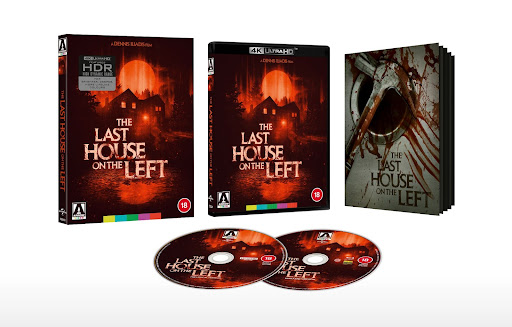
Murderous criminal Krug is being driven in police custody prison when he’s rescued by his girlfriend Sadie and brother Francis, with two officers paying with their lives. Meanwhile Emma and John Collingwood, and their daughter, competitive swimmer Mari, go to spend some time at a lake house owned by their recently deceased son Ned. Mari borrows the family car and drives into town to spend some time with her friend Paige. A teenager named Justin invites them both back to his roadside motel room to smoke marijuana. However, Justin’s family members return, who turn out to be Krug, Francis and Sadie. Krug is angry at Justin for bringing unknown people to their motel room, and shows him a local newspaper that has Krug and Sadie’s pictures on the front page. Believing it would be too risky to let Paige and Mari go, the gang kidnaps them and uses their car to leave town….
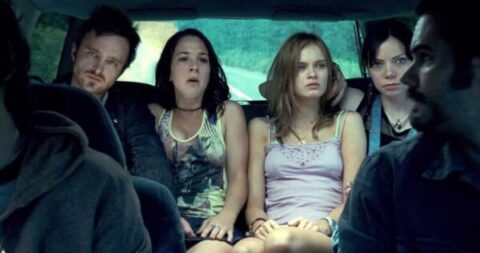
The subject of remakes often comes up when discussing movies, and perhaps especially horror movies, especially as we seem to live in a time where you can’t go for a month without a remake of some favourite being announced. I recall feeling rather baffled when the new version of Wes Craven’s grotty, disturbing and hugely effective 1973 shocker was announced. Granted, we’d already had remakes of fellow ’70s terror classics The Texas Chainsaw Massacre, The Hills Have Eyes and even Lord Almighty I Spit On Your Grave, but it was very strange to think that a such a film, a film which was only legally available uncut in the UK in 2001, was getting a Hollywood remake and a general cinema release [the redo of Meir Zarchi’s much hated film largely bypassed theatres] at that. How times had changed. As I often did, I went into the cinema expecting to dislike this new version, even if the other remakes had all turned out rather well and certainly didn’t compromise. In fact it became my favourite out of the four, something which probably remains even if a few flaws do seem more evident now. While the Hollywood gloss greatly diminishes the gritty feeling of realism which made Craven’s film so powerful, it still achieves a high level of intensity and is actually even gorier while tweaking the story somewhat. One can debate on how well the latter was achieved. Characters are developed, parts of the plot make more sense, and one particular alteration – the equivalent of the Junio character in the original being more active and instrumental in moving the story along – is nice to watch. However, some fans of the original will say that “nice” shouldn’t be a part of this film, and that the story being less bleak in more than one respect is an insult to what Craven gave us in 1973. However, as I’ve not long said, it was a Hollywood production, and taken on its own I believe it’s as good a revenge-themed horror as we ought to have to right to expect. It’s exciting, gruesome and rather well acted.
Craven actually initiated this remake, intending to produce it, saying that in 1972 he didn’t have the budget to film every piece of the story he wanted to tell. Eli Roth was originally approached to direct, as he’d attempted to get a remake off the ground years prior, but turned it down [apparently on advice from Quentin Tarantino] to do Hostel: Part 2. Dennis Iliadis was eventually chosen because the producers were impressed with his debut feature film Hardcore, which explored the world of teenage prostitution. Adam Alleca’s original script contained supernatural elements; it was rewrittten by Carl Ellsworth. Filming took place in South Africa; Cape Town and the Helderberg Nature Preserve. Craven chose to give Iliadis a lot of freedom as he was also making My Soul to Take. Illiadis’s quest for realism extended to the bringing in of a medical technician who would explain how someone would react given a particular violent event, like getting shot or stabbed. Though this isn’t mentioned on this Blu-ray, some sources say that wasn’t originally intended for a cinema release. The MPAA required some cuts for an ‘R’ rating. I watched the “Unrated” Version. For quite a while all we get are a few extra, longer or replaced shots, and a brief extra dialogue exchange. Some, such as Sadie caresses Mari’s neck for longer and Paige is squirming on the ground, were clearly cut for censorship, but many others are pointless, simply indicating that Illiadis and his editor took the opportunity to recut a lot of footage to presumably tighten the film. Once the abuse begins the footage increases, with a stabbing followed by a rape which is nearly a minute longer, though after that it’s back to inconsequential additions and occasionally deletions. The Last House on the Left did reasonable box office.
The opening few seconds immediately set a forbidding mood as the camera tracks through a forest at nighttime, passing tree trunks before the whole screen goes black. I was obviously decided that we needed something exciting to happen right from the offset, and to introduce our villains early so we were on tenterhooks wondering when they’ll show up again. A man telling some unfunny joke about a brothel to the other man sitting next to him in a car perhaps suggests that there will be humour in this film, but that’s all we get, so those who disliked those goofy cops in 1973 were well served. The car is actually a van with a prisoner caged in the back. After a bit of taunting another car slams into them in what is a real sudden shock, causing a crash. Said prisoner, Krug, has understandably been a little injured, but he’s pleased to be free as he joins his brother and girlfriend. Sadie shoots one of the officers, but Krug is more cruel with his own victim, breaking his neck while forcing him to look at a photograph of his two young daughters, in what’s a quite upsetting moment considering it’s so early on. We’ve learnt that Krug is as nasty as they come, and that this film will not hold back. We cut now to slow motion footage of a girl swimming which can only come across as cheesy by comparison, but that was no doubt the idea. The class aspect slightly hinted at in the original is now a major factor as Mari’s parents are clearly pretty well off with their more lavish house, guest home and large swimming pool. There’s a perhaps unnecessary scene of Emma the mother being in the hospital to which the bodies have been taken, though I guess you could also take it as neat foreshadowing, these two stories already being linked. Then it’s off to the holiday home, which has sadness about it because its owner, Mari’s brother, recently died. There’s a slightly strange moment when Mari comes out of the shower and the camera seems to ogle her in closeup as she gets dressed. I didn’t mind it that much, but I’m sure some have found it unnecessarily exploitative.
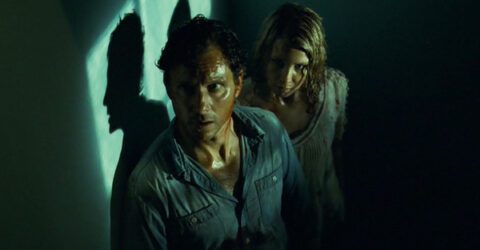
To the dismay of mother, Mari drives off to see friend Paige in the shop where she works. Paige wants to go and get stoned, but Mari doesn’t “really do that stuff anymore”. Nonetheless when an offer from a teenage boy who tries to buy cigarettes without ID concerning some “good stuff” comes along, Mari is happy to drive the other two to the motel where Justin says the gear is, and wait in the car for Paige to come back out with it, but Paige seems to have forgotten about her so Mari eventually decides to join them. There’s good buildup here, with the modern horror device to create vulnerability NO PHONE SIGNAL, two cheap scares, Justin not showing them a blood stained note, and the two girls taking a bit of a shine to this boy who with a makeover could look cute, being well handled. “What do they do”? asks Paige of Justin’s family. “All sorts of things” replies Justin. Maybe he doesn’t know how nasty they are yet, though I find that hard to believe. We do have a little bit of sympathy for him though when he says that his mother died [I wouldn’t be surprised if Krug was responsible], even if we’re not yet sure if he deliberately lured the girls there so his family can find them, of if he did it just because he was lonely and wanted some fun. Then in they come, Mari and Paige immediately finding it odd that Sadie casually takes off her toip in front of them as if it was nothing, and the intensity immediately becomes pretty strong and is sustained for a long period of time as the sense of threat increases and increases. We know that Mari’s swimming expertise is going to come in handy, but surely it won’t do her much good in the end. As everyone probably knows, the gang then takes shelter in the Collingwood household where John treats his injuries, and it really is edge of seat stuff as we’re waiting for the two parents to find out who they really are and what they’ve done.
The less convincing elements of the plot have been slightly altered so they make more sense i. e. the reason why the gang end up in the Collingwood house in the first place. The biggest change to the plot is a different matter. It was quite well let out at the time, though it would have come as a huge surprise to many and probably a disappointment to some who didn’t know about it. I debated whether to reveal it, and eventually decided not to, just in case some readers don’t know what I’m talking about. But I will say that not only is the revelation of it hard to believe, but it considerably changes the mood, allowing things to be more positive even if some suspense is still created. The two most unpleasant bits in the original film aren’t repeated here, but along with more escape attempts we do get a fair bit of physical violence culminating in a rape scene which, at least in its Unrated form, is nastier than the one seen in 1973 even though it’s actually somewhat tasteful in the way that it’s shot; this just shows what a good filmmaker Illiadis is, achieving a powerful effect through his choice of shots – for example the avoidance of skin – while not being prurient. Unsurprisingly the revenge section is more elaborate. Graphic nose stitching and bullet removal may cause some to cringe more than the ways with which the villains are dispatched. A shooting through an eye is a highlight, though you can say with some justification that Craven not showing graphic gore or not having the money to show graphic gore made us question the violence more and not let us actually enjoy it. One death is a little silly and the lengthy climactic fight gets a little absurd too, but it’s exciting and well staged so we can mostly forgive that.
The performances are generally spot on. Of course it’s doubtful that any actor could match David Hess as Krug, but at least Dillahunt opted to go down a different route. He’s more subtle for a lot of the time, and this time we get a sense that he does actually love his son, even though he’s extremely misguided as to the kind of man he wants him to be. The class element is mostly given to Riki Lindhome’s Sadie, who’s full of envy for this seemingly privileged family. The film is extremely well lensed by Sharone Meir, with lots of smooth long takes yet also some excellent use of closeups when deemed necessary. An aerial shot of a girl lying dead in the water, her arms outstretched as if she’s crucified while the stars of a night sky being reflected on her, is very memorable and almost poetic. John Murphy’s music score hits the right dramatic notes and there’s no bluegrass this time. All in all it’s quite amazing how well they did with this remake, which makes it all the more a shame that it ends with a silly final burst of gore as a sort of final joke, which sadly takes it well away from not just what Craven was going for in 1973, but also what Illiadis and his screenwriters seem to have been gong for; sort of makes a mockery of the seriousness of what we’ve previously been watching. Oh why, just why?! But then the good thing about it being at the end is that you can switch the film off just before it, something I wholeheartedly recommend.
Rating: 









I watched the Blu-ray, so scroll down a bit further to check out my thoughts on the picture quality and the special features.
4K ULTRA HD BLU-RAY LIMITED EDITION CONTENTS
Two version of the film: the original Theatrical Version (4K Ultra HD Blu-ray) and the Unrated Version (Blu-ray)
Original uncompressed stereo audio and DTS-HD MA 5.1 surround audio for both films
Optional English subtitles for the deaf and hard of hearing on both films
Illustrated collector’s booklet featuring new writing on the film by Zoë Rose Smith
Reversible sleeve featuring original and newly commissioned artwork by Eric Adrian Lee
DISC ONE – THEATRICAL VERSION (4K ULTRA HD BLU-RAY)
4K (2160p) Ultra HD Blu-ray presentation in Dolby Vision (HDR10 compatible) of the original Theatrical Version of the film
Exclusive new filmed introduction by director Dennis Iliadis
Brand new audio commentary by David Flint and Adrian Smith
A River of Blood, a new 31-minute interview with Sara Paxton
The Notorious Krug, a new 27-minute interview with actor Garret Dillahun Suspending Disbelief, a new 18-minute interview with screenwriter Carl Ellsworth
Reviving the Legend, a new 33-minute interview with producer Jonathan Craven
Look Inside Featurette, from the films original 2009 release.
Deleted scenes
Theatrical trailer
Image gallery
DISC TWO – UNRATED VERSION (BLU-RAY)
High Definition Blu-ray (1080p) presentation of the Unrated Version
BLU-RAY LIMITED EDITION CONTENTS
Two version of the film: the original Theatrical Version and the Unrated Version
Original uncompressed stereo audio and DTS-HD MA 5.1 surround audio for both films
Optional English subtitles for the deaf and hard of hearing on both films
Illustrated collector’s booklet featuring new writing on the film by Zoë Rose Smith
Reversible sleeve featuring original and newly commissioned artwork by Eric Adrian Lee
DISC ONE – THEATRICAL VERSION
High Definition Blu-ray (1080p) presentation of the original Theatrical Version of the film
Both versions look excellent, though the original release looked pretty darn good too. This one provides the increased sharpness, detail and depth one should expect but retains most of the deliberate graininess and deliberately heightened contrast that was previously present, resulting in a hugely satisfying watch whether you’ve seen the first release or not.
Exclusive new filmed introduction by director Dennis Iliadis [8 mins]
Longer than most director introductions, this has Illiadis, who seems very pleased about this release and proud of the film, discuss the production a bit, including how he, Craven and an executive didn’t talk about the horror aspects on their first meeting. He also defends the rape scene and is in two minds about the ending, which preview audiences happened to love [for some reason]!
Brand new audio commentary by David Flint and Adrian Smith
Quite often people who are doing an audio commentary suggest that viewers watch the film without it first. Flint and Smith go one further and wonder why on earth somebody would even want to do that. They don’t give us a lot of background information, and are only occasionally scene specific, but do provide a nice, relaxed, appreciative chat. In fact, they make such a good case for this being such a good remake, noting a lot of improvements, that they’re basically saying that it’s better than the original in so many words. They even like the biggest change in the plot,though they’r not too keen on the final scene thankfully. Smith is brave enough to claim that Roger Ebert, who praised the original but later turned against this kind of film, “changed his views to suit the reactionary, conservative word of ’80s America”, and that, in discussing rape revenge films, women often enjoy them more than men. These things could be true, though I’m not sure. Not as informative as I wished but still most enjotable to listen to.
River of Blood, a new 31-minute interview with Sara Paxton
Paxton, who loves horror movies, goes into a lot of detail here about her time making this film. One great story has baboons attacking the location manage, another has her catching landing on Spenser’s face while trampolining; when back on the set her simply said, on account of his bruised face, “I fell”. She was very relaxed while filming the rape scene and found it hard to take Dillahunt, which he’d worked with before, as a bad guy.
The Notorious Krug, a new 27-minute interview with actor Garret Dillahunt
Dillahunt, who also likes horror films but isn’t keen on the ending, says that the forest that much of the film was shot in was actually one specifically planted go provide a renewable source of lumber, how he went to see Iron Man and was shocked to see that Robert Downey Jr sported his beard, and that he had to split his pants to get low enough for the shooting of the rape scene.
Suspending Disbelief, a new 18-minute interview with screenwriter Carl Ellsworth
Ellsworth begins by saying he’s not keen on the original because of its lack of hope, and that Craven and co-producer Marianne Maddelena agreed with his views. He even says that he likes rewrites that cast members did. He’s not keen on the ending either. We learn that his father-in-law came up with the ending, and he wrote it not thinking it would remain in the film, yet it got it greenlit!
Reviving the Legend, a new 33-minute interview with producer Jonathan Craven
Craven, who appears as the boy who has his balloon popped, reminisces about being on the set and in the editing suite during the filming of the original, as well as defending horror movies in a school class against the Vice Principal who denounced them, but is most interesting talking about the troubles with the MPAA – his father said “lay in some piano music” to soften one scene. It worked in the opinion of the MPAA, then afterwards they took it off. He doesn’t like the ending either.
Look Inside Featurette, from the films original 2009 release [2 mins]
“I think he made a bigger classic than the original” says Wes in this little promo which was on the original disc from Universal,. while Iliadis says the film is “about human nature”.
Deleted scenes [11 mins]
Also on the older release, these suffer from having a stretched picture, but there’s some good stuff here, right from where Mari says goodbye to her father and the car stops after a couple of seconds of driving; “oh you’ve broken it” says a crew member. Theres’ also more of the two girls in the shop, Emma showing Krug and company to the other house where they can sleep, and the villains being unable to sleep. I’d have liked the latter scene to have stayed in, even though it’s hardly essential.
Theatrical trailer
Image gallery
DISC TWO – UNRATED VERSION (BLU-RAY)
High Definition Blu-ray (1080p) presentation of the Unrated Version
I do slightly prefer this version for its stronger content and different editing of some scenes, so would suggest that you view it first.
Arrow Video significantly improve on its initial release and give one of the best horror remakes a release it deserves. Highly Recommended – even if you admire the original so much that you’re unsure about this version or couldn’t help but dislike it on your first viewing!


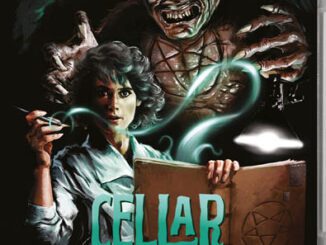

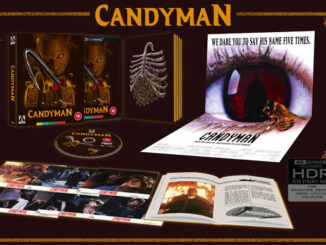
Be the first to comment